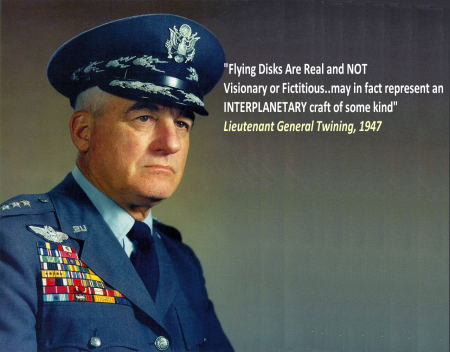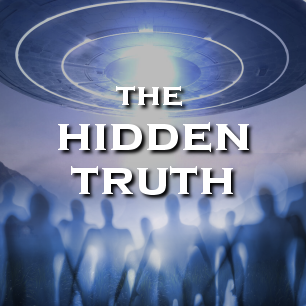Blog Categories
- African Incidents
- Atlantis Incidents
- Australian Incidents
- Belgian Incidents
- Bermuda Triangle Incidents
- Brazilian Incidents
- Canadian Incidents
- Chinese Incidents
- European Incidents
- France Incidents
- Ghosts
- Giants
- Italy Incidents
- Japanese Incidents
- Middle East Incidents
- Portugal Incidents
- Project Serpo
- Puerto Rico Incidents
- Russian Incidents
- Sasquatch
- Scandinavia Incidents
- Spanish Incidents
- UFOs
- United Kingdom Incidents
- United States Incidents
1947: US General Admits That UFOs Are Real

On September 23rd, 1947, Lieutenant General Twining, Commanding General of Air Materiel Command, sent a secret memorandum to Brigadier General George Schulgen, Chief of the Air Intelligence Requirements Division at the Pentagon, in response to a request from Air Intelligence concerning the "flying disks".
In the opinion of AMC, arrived at in a conference with personnel from the Air Institute of Technology, Intelligence T-2, the Office, Chief Engineering Division, and the Aircraft, Power Plant, and Propeller Laboratories of Engineering Division T-3, Twining stated:
The phenomenon reported is something real and not visionary or fictitious. There are objects probably approximating the shape of a disk, of such appreciable size as to appear to be as large as man-made aircraft. The reported operating characteristics such as extreme rates of climb, maneuverability, (particularly in roll), and action which must be considered evasive when sighted or contacted by friendly aircraft and radar, lend belief to the possibility that some of the objects are controlled either manually, automatically or remotely.
Twining’s report went on to list the apparent common descriptions of the objects:
(1) Metallic or light reflecting surface.
(2) Absence of trail, except in a few instances when the object apparently was operating under high performance conditions.
(3) Circular or elliptical in shape, flat on bottom and domed on top.
(4) Several reports of well-kept formation flights varying from three to nine objects.
(5) Normally no associated sound, except in three instances a substantial rumbling roar was noted.
(6) Level flight speeds normally above 300 knots are estimated.
The AMC recommended that Army Air Force Headquarters issue a directive assigning a priority security classification and code-name for a detailed study of the disks, including the preparation of complete sets of all available and pertinent data, to be made available to the Army, Navy, Atomic Energy Commission, Joint Research and Development Board, (set up by Dr. Vannevar Bush), National Advisory Committee on Aeronautics, Air Force Scientific Advisory Group, RAND, (a West Coast think tank), and NEPA, (Nuclear Energy for Propulsion Applications).
Twining’s report stated that there was a "lack of physical evidence in the shape of crash recovered exhibits which would undeniably prove the existence of these objects", a statement that has been used by debunkers such as Philip J. Klass to dismiss the claim that Twining had examined the Roswell debris. But Twining must surely have been aware of the wreckage since it had been flown to Wright Field, (AMC Headquarters), for examination, so why did he cite the lack of physical evidence?
As William Moore explains, if a disk had crashed at Roswell, Twining would have needed to set up a project to gather as much information as possible from all over the world. Assuming that access to crashed disk data would have been on a very high "need-to-know" basis, it would hardly have been appropriate to let those on the other end of the data collection line know why such data was needed. "Indeed", argues Moore, "it might have been best to maintain that there was no crashed disk in order to allay suspicion."
There is strong evidence that the Air Intelligence Requirements Division, headed by Brigadier General Schulgen, to whom Twining had sent the AMC report, was aware of the crashed disk material, and that this information could only have come from Twining’s office. A secret AIRD five page "Draft of Collection Memorandum" dated 28 October 1947, listing the "current intelligence requirements in the field of Flying Saucer type aircraft" gives much of Twining’s AMC data on the phenomenon, and adds some significant and revealing comments: "While there remains a possibility of Russian manufacture, based upon the perspective thinking and actual accomplishments of the Germans, it is the considered opinion of some elements that the object may in fact represent an interplanetary craft of some kind". Listed under "Requirements ... are":
Items of construction
(a) Type of material, whether metal, ferrous, nonferrous, or non-metallic.
(b) Composite or sandwich construction utilizing various combinations of metals, metallic foils, plastics, and perhaps balsa wood or similar material.
(c) Unusual fabrication methods to achieve extreme light weight and structural stability."
Under "Power plant" the draft memorandum states: "Information is needed regarding the propulsion system of the aircraft. The presence of an unconventional or unusual type of propulsion system cannot be ruled out and should be considered of great interest".
Some of this information simply must have come from Twining’s office. The reference to "various combinations of metals, metallic foils, plastics, and perhaps balsa wood or similar material" is of course particularly significant in that it closely matches Major Jesse Marcel’s description of the Roswell wreckage.
My Take: There you have it. Another smoking gun and not enough people are paying attention.
Resources: Above Top Secret, Timothy Good, 1988

On September 23rd, 1947, Lieutenant General Twining, Commanding General of Air Materiel Command, sent a secret memorandum to Brigadier General George Schulgen, Chief of the Air Intelligence Requirements Division at the Pentagon, in response to a request from Air Intelligence concerning the "flying disks".
In the opinion of AMC, arrived at in a conference with personnel from the Air Institute of Technology, Intelligence T-2, the Office, Chief Engineering Division, and the Aircraft, Power Plant, and Propeller Laboratories of Engineering Division T-3, Twining stated:
The phenomenon reported is something real and not visionary or fictitious. There are objects probably approximating the shape of a disk, of such appreciable size as to appear to be as large as man-made aircraft. The reported operating characteristics such as extreme rates of climb, maneuverability, (particularly in roll), and action which must be considered evasive when sighted or contacted by friendly aircraft and radar, lend belief to the possibility that some of the objects are controlled either manually, automatically or remotely.
Twining’s report went on to list the apparent common descriptions of the objects:
(1) Metallic or light reflecting surface.
(2) Absence of trail, except in a few instances when the object apparently was operating under high performance conditions.
(3) Circular or elliptical in shape, flat on bottom and domed on top.
(4) Several reports of well-kept formation flights varying from three to nine objects.
(5) Normally no associated sound, except in three instances a substantial rumbling roar was noted.
(6) Level flight speeds normally above 300 knots are estimated.
The AMC recommended that Army Air Force Headquarters issue a directive assigning a priority security classification and code-name for a detailed study of the disks, including the preparation of complete sets of all available and pertinent data, to be made available to the Army, Navy, Atomic Energy Commission, Joint Research and Development Board, (set up by Dr. Vannevar Bush), National Advisory Committee on Aeronautics, Air Force Scientific Advisory Group, RAND, (a West Coast think tank), and NEPA, (Nuclear Energy for Propulsion Applications).
Twining’s report stated that there was a "lack of physical evidence in the shape of crash recovered exhibits which would undeniably prove the existence of these objects", a statement that has been used by debunkers such as Philip J. Klass to dismiss the claim that Twining had examined the Roswell debris. But Twining must surely have been aware of the wreckage since it had been flown to Wright Field, (AMC Headquarters), for examination, so why did he cite the lack of physical evidence?
As William Moore explains, if a disk had crashed at Roswell, Twining would have needed to set up a project to gather as much information as possible from all over the world. Assuming that access to crashed disk data would have been on a very high "need-to-know" basis, it would hardly have been appropriate to let those on the other end of the data collection line know why such data was needed. "Indeed", argues Moore, "it might have been best to maintain that there was no crashed disk in order to allay suspicion."
There is strong evidence that the Air Intelligence Requirements Division, headed by Brigadier General Schulgen, to whom Twining had sent the AMC report, was aware of the crashed disk material, and that this information could only have come from Twining’s office. A secret AIRD five page "Draft of Collection Memorandum" dated 28 October 1947, listing the "current intelligence requirements in the field of Flying Saucer type aircraft" gives much of Twining’s AMC data on the phenomenon, and adds some significant and revealing comments: "While there remains a possibility of Russian manufacture, based upon the perspective thinking and actual accomplishments of the Germans, it is the considered opinion of some elements that the object may in fact represent an interplanetary craft of some kind". Listed under "Requirements ... are":
Items of construction
(a) Type of material, whether metal, ferrous, nonferrous, or non-metallic.
(b) Composite or sandwich construction utilizing various combinations of metals, metallic foils, plastics, and perhaps balsa wood or similar material.
(c) Unusual fabrication methods to achieve extreme light weight and structural stability."
Under "Power plant" the draft memorandum states: "Information is needed regarding the propulsion system of the aircraft. The presence of an unconventional or unusual type of propulsion system cannot be ruled out and should be considered of great interest".
Some of this information simply must have come from Twining’s office. The reference to "various combinations of metals, metallic foils, plastics, and perhaps balsa wood or similar material" is of course particularly significant in that it closely matches Major Jesse Marcel’s description of the Roswell wreckage.
My Take: There you have it. Another smoking gun and not enough people are paying attention.
Resources: Above Top Secret, Timothy Good, 1988

